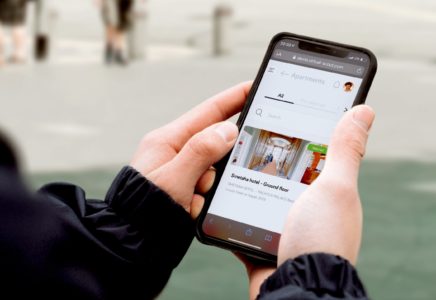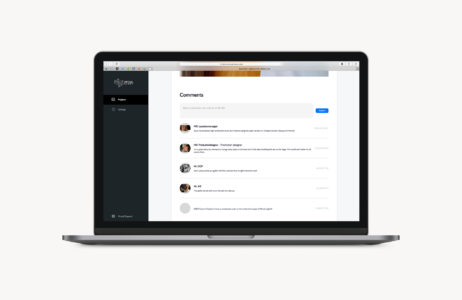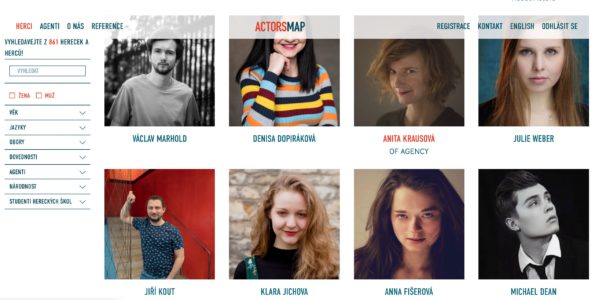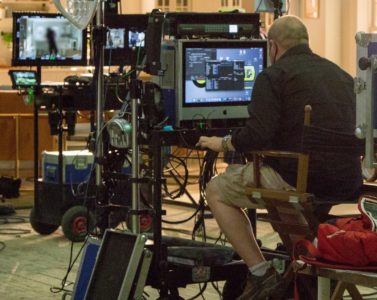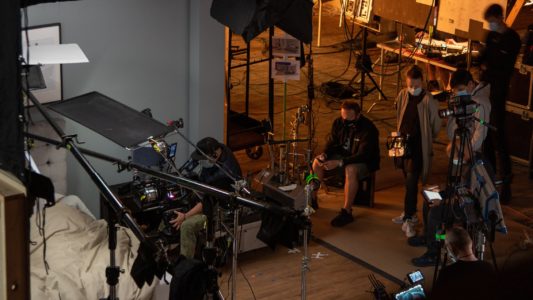Films have been made in more or less the same way since their very beginning. First an idea, then a screenplay, the producers secure financing. A basic crew sets out on location tours; castings are held, and extras selected; the whole crew must be hired; equipment, locations, studios for the construction of decorations, production offices must be rented; and many other things will need to be arranged and organized. If it’s an international production, some of the filmmakers will fly to the Czech Republic from all corners of the world. Film production is like a living organism, where everyone knows what to do, and everyone works together. Then comes the first day of filming. The crew, which often numbers in the hundreds, gathers on the set, and it’s lights, camera, action!
From this very brief outline of how a film shoot is organized, it’s clear that it requires highly professional leadership. And hand in hand with leadership goes the knowledge of the latest film technologies. These are continually being improved and permit approaches that were completely unheard of a few years ago. Let’s take a look at what aspects of film prep can be taken online to help save not only time but also money.

Bohemian Pictures and Mirada remote shooting | Photo: Nikolas Šilar
Scout movie locations from the comfort of your living room
The director and production designer usually have a clear idea of the locations they need for their film, series or advertisement. The commonly used selection of photos will give a general idea of what a particular place looks like. Still, other aspects are also important – in the case of an interior, for example, how the rooms are arranged, how big they are, or what they look like when standing in the middle and looking around.
This was the impetus for the creation of Virtual-scout.com in the Czech Republic, a platform where location companies present film spaces in a 3D format. Location manager Robert Mehrle is very excited about it: “Virtual-scout saves us so much work – through it, we can send the client a link for a specific project, where all documents, communications, and photos are uploaded. Everyone will find what they’re looking for, and it eliminates the confusing mass of e-mail messages. Every new 3D scan we do teaches us something new. We share our experiences with the platform developers so that the final instructions on how to properly scan a location can best help other users.”
According to Mehrle, it is essential to do a smooth virtual tour, as well as to be able to see the street with the help of views from the windows, which camera operators who need to define the position of lighting towers or cranes for the gaffer also appreciate. For better orientation of the compass directions, it is possible to place a compass rose on the window and then insert a link to the exact position in the virtual tour using a special application. These features will already be integrated into the new version of Virtual-scout.
Now what everyone’s interested in – the price difference between shooting a location with a regular camera and shooting with a special 3D camera. A flat fee for the use of the exclusive technology will be added to the usual amount. The location is scanned thoroughly, eliminating the need to return to re-photograph a specific angle. You can scan and publish, for example, the interior of a car, yacht, plane, or train – whatever the client wants to see. Location managers can read recommendations on which camera to use in which space, how the scanning procedures differ for different cameras, and a list of local companies that lend this equipment or that can perform the scan upon request.
What are the benefits for the producer and the director? They don’t have to wade through hundreds of images, but instead, they can walk virtually through a space and get an exact idea of what the location is like in a few minutes. And of course, security is a priority: only a registered user authorized by the creator of the images can access the photos and plans. Communications and any attachments are encrypted and stored on secure servers.
At the time of publication of this article, the platform is still in trial operation. Developer Jan Tůma and his team are working to improve the system further: “We’re developing a solution that will reflect even the needs of film productions even better. For example, virtual tours with stored camera positions, views of the location through specific camera lenses, simulations of the path of the sun at a given place or at a set time, and many other tweaks.”
Actors made to measure
Are you looking for an actor for your film who can juggle on a skateboard while singing in French? With Actorsmap, you can find one in minutes. Although this database of actors has only been in operation for four months, it has already garnered plenty of support. Users especially like the quick search and sorting using the smart menu, as well as the option to contact the selected actors or their agents directly through the system.
Every Czech or Slovak professional actor or acting student can register on Actorsmap. They create a profile, add skills and knowledge, photos, videos, and a link to their website and contact information. They can update their profile at any time. The website is in both Czech and English, so the database is easily accessible to foreign filmmakers.
Barbora Fabiánová, from one of the five acting agencies behind the creation of the database, sheds light on its mission: “We created Actorsmap to assist directors, casting directors, producers, production managers, acting agencies and agents, art projects, but above all actors. But it doesn’t fully replace casting – you always need a casting director to ensure high-quality casting. No project can take place without one. For casting directors, our database is a tool that makes their job easier, offers them inspiration, and has everything in one place, clear and up to date. It finds contacts for actors or their agents here, and makes it easy to find out who, for example, speaks a foreign language or has a skill needed for a given project.”
Actors pay an annual membership fee, students pay a lower fee, and agents receive a volume discount. During the corona crisis, the site operators gave actors free memberships for a year to support them in these difficult times. Currently, the database features almost 900 actors and actresses to choose from.
Applications for casting agencies – online casting
Casting is not an easy discipline. You have to meet the demanding expectations of clients or the director, react quickly to changes, and maintain a constant overview of the project, which requires making calls, keeping up with paperwork, and creating various spreadsheets. Barbora Roubová knows this from personal experience, so she and her husband developed a unique cloud database solution for casting actors and extras, drawing from her own experience: “When working with casting agencies and arranging extras for Czech and international commercials and films, it was clear to me what takes up the most time. And the idea for a project that would simplify the whole system was born.”
And so ROLETIK was created, a system intended for all extras and casting agencies. In this application, the casting director can easily create a project and choose who they are looking for and for what days and times. They create a questionnaire and can share it on social networks. Those interested in the role of extras who apply through the app will immediately appear in their database. From the replies, they can select the candidates they’re interested in and send them a message directly via the SMS gateway or by e-mail, either individually or to the whole group at once.
After contacting the selected extras, the system records their responses. If they accept the offer, they will be displayed for the requested days and roles. The casting director always has an up-to-date overview of which role remains to be filled and on what days. With one click, they can easily create a clear PDF with all those interested, their photos, and data.
The casting director can invite clients and colleagues by e-mail to view the project and choose what information they can access. In this way, they have the opportunity to view current information either from a computer or from a mobile phone. ROLETIK includes, among other things, ratings of registered extras.
Director’s home office
Filming is imminent, but the director broke his leg at a pool party in Los Angeles? The cameraman missed their plane? Surprisingly, the agency and the client from the other side of the world don’t have time for a trip to Mother Prague? “Remote shooting” can resolve this. It’s a process during which some members of the staff are not physically present at the shooting but instead participate via the internet, no matter where they are.
QTAKE Cloud Stream technology, an extension of the QTAKE HD Video Assist device, has been in use in the Czech Republic since 2017. Video Assist is a video recording monitor on which the director and cameraman can see the result of the shot. Previously, footage was recorded on video cassettes; now things are more advanced and digital recording is used.
QTAKE Cloud Stream can do much more. You can immediately view footage from up to 4 cameras at once anywhere in the world. All you need is an internet connection and a unique code for cloud access. One transmission can have up to 160 codes. The operator sees who has just joined, monitors everything, and can immediately disconnect and reconnect anyone as needed. You don’t have to worry about the recorded material leaking to the public. This technology is fully endorsed and used by major players in the film industry, such as Disney, Marvel, Netflix, Amazon, and Sony, which is a testament to its reliability and security.
What’s the delay between the monitor in Los Angeles and real-time at the location or studio in Prague? Quite minimal – only about 4-6 movie frames (approx. 100-150 milliseconds), which allows the remote director to work as if he were on site. They are helped by a reverse audio line, the Director’s Talkback, which enables them to communicate via a speaker on the set. Regular communication between the set and the remote crew members takes place using Zoom video conferencing, which is routed via a computer to the headphones of those crew who need it – usually the first assistant director, the focus puller, and the video operator. All you need to do is to ensure the shoot time is feasible for remotely connected members in another time zone.
Sounds great, doesn’t it? Plus, it’s not difficult to set up. You need to have a QTAKE Cloud Stream license (leased), basic network infrastructure for use with QTAKE, and a good quality internet connection. What’s important is that the upstream speed (uploading from the user to the internet) and configuration (quality and resolution) be in the range of 5-30 Mbps, which most wireless mobile connections can handle. The client receives video on any Apple device using the QTAKE Monitor application and their ID number, under which they register and receive access to the video.
Even during the state of emergency, an eight-day shoot for an advertisement for an American client took place in the Czech Republic. Video operator Viktor Lonek was there and gave us insight into the technology used: “As far as I know, it was the first such long fully-remote shooting that worked just like a classic shoot – the construction of set decor, a full crew. The only difference was that the director, agency, and client were not physically present on the set. It was a great experience and showed that it’s possible to shoot like this without any problems if everything is set up properly.”
Producers Mirka Taylor and Sherry Baumgart outlined how the discussions regarding remote shooting took place: “The American production company we were shooting for was very eager to make their project a reality, so they were very open to suggestions. Probably the most difficult thing was to come up with a plan to fulfil all the requirements of the shoot. There was no one to advise us on what worked; we didn’t know anyone who could lead something on this scale to a successful conclusion. Eight days is quite long for an advertising shoot. We also needed to ensure that the crew was protected properly during the global Covid-19 pandemic. Once we convinced ourselves that it was possible, everything was easier, and we knew we could do it.”
This experience illustrates one of the main advantages of filming in the Czech Republic. We’ve got experienced, skilled film professionals with creative ideas who not only use the latest technologies but also develop new platforms and applications. Czech ingenuity and the ability to quickly adapt to unexpected situations thus proved to be almost literally priceless. Audiovisual production in the Czech Republic relaunched fully at the beginning of May. With the help of the technologies mentioned above, you can easily implement your project with a Czech partner now.

